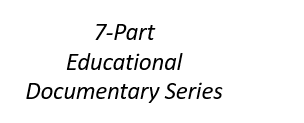A seven-part documentary series on the incarceration of Japanese Americans and its relevance for us today!
This seven-part series was designed as thought-provoking educational material for classroom and small group discussion, for the purpose of inspiring people to become informed and politically involved in decision making that effects our communities, and our country; for the opportunity for discussion between Americans with differing views.
1: UPROOTED
This program introduces the “We the People Series” beginning with stories of the immigration of Japanese people to the U.S., their integration into American society, and the ramifications of the attack on Pearl Harbor, December 7, 1941.
Weeks later President Franklin Roosevelt signed Executive Order 9066 ordering all Japanese American citizens and their families living on the West Coast to be rounded up, removed from their homes, their properties seized. They were then sent initially to relocation camps designated as Assembly Centers, and later to permanent Incarceration Camps.
Video | Discussion Guide | Home
(Video Length: 17 Min.)
2: THE INCARCERATION OF JAPANESE AMERICANS
This program looks at what the process of the incarceration entailed for Japanese American families, living in the “Exclusion Area” of the West Coast of the United States. The United States Government sent these families east from the assembly centers in Washington, Oregon, California and Arizona to ten permanent incarceration camps in seven states. This program examines the life and spirit of the incarcerated people and what was necessary to maintain for their family’s wellbeing while confined in incarceration camps surrounded by barbed wire fence and armed guards.
Video | Discussion Guide | Home
(Video Length: 21:40 min)
3: GO FOR BROKE!
The gradual involvement of Japanese American men and women in the U.S. armed forces after Pearl Harbor is presented in this program. For some, the initial training in the Military Intelligence Unit (a secret language school) provided mostly unseen translators, interrogators, and code breakers for the war. When the war efforts became more dire, military leaders understood the loyalty of the Japanese American men and they were finally welcomed into the U.S. armed forces. In fact, the 100th Hawaii Battalion and 442nd Regimental Combat Team became, for its size the most decorated unit in the history of the U.S. Military.
Video | Discussion Guide | Home
(Video Length: 14:35)
4: THE RETURN HOME
The bittersweet return, at the end of 1945, of the Japanese American families back to what had previously been called “the exclusion area.” Their three main fears upon reentry were: being treated as a foreign enemy, anxiety about their economic future, and whether fire or police departments wouldn’t be there for them if necessary. Some found their land had been guarded by good neighbors, others came back to burned homes, squatters living in them, or businesses sold. They knew racist slurs would be waiting for them upon their return.
Video | Discussion Guide | Home
(Video Length: 14:07 Min.)
5: PEOPLE WHO HELPED
Viewers are introduced to Americans of all ages, races, ethnic backgrounds, and religious affiliations who responded to the needs of their Japanese American neighbors who were treated so unjustly and illegally by the U.S. government. Humanitarian outreach from both large organizations and individuals included: living and teaching in incarceration camps, loaning neighbors money to rebuild their lives, opening relocation hostels throughout the U.S., and providing access to higher education.
Video | Discussion Guide | Home
(Video Length: 16:10 Min.)
6: RACISM & REDRESS
This program begins with the Civil Rights moment then raises the enduring problem of racial exclusion in our country. The call for redress and monetary reparation to former Japanese American internees was a way to force dealing with the issue publicly. Leaders of the Japanese American Citizens League launched the redress process and, over time and with the help of the Federal Commission on Wartime Relocation and incarceration of Civilians, the Civil Liberties Act was signed into law. The program concludes by addressing the origins of discrimination in America with the arrival of European settlers and the cultural attitudes they held toward the native peoples they encountered.
Video | Discussion Guide | Home
(Video Length: 15:00 Min.)
7: COULD THIS HAPPEN AGAIN? *
The framers’ challenge, when they created our country’s constitution, was to create a framework for the citizens of our country to continue the work of the constitution by constantly moving toward a more just and perfect union. The final program in the series focuses on three main areas. First: the cause of the incarceration of Japanese Americans, identified by a federal commission, was racism, war hysteria – which today would be called the politics of fear – and the failure of political leadership. Second: how people were guided toward prejudice against Japanese and Japanese Americans through movies, books, schools, universities, national organizations, family bias and fear. Third: how each of us might be failing to uphold the promise of the Constitution for others and ourselves. Our first president, George Washington, urged all citizens of our fledgling democracy to grow in awareness, social consciousness, civic responsibility, and personal involvement.
Video* | Discussion Guide | Home
(Video Length: 20:35)
*This program could also be used as two separate discussion sessions:
– How the incarceration happened 00:00 – 08:34
– Why the incarceration happened 08:35 – 19:00
